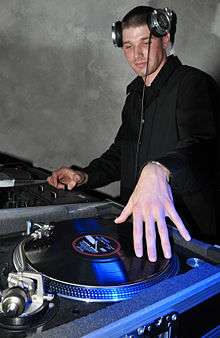DJ mixer
A DJ mixer is a type of audio mixing console used by DJs to make smooth transitions between different sound recordings as they are playing. The sources are typically record turntables, compact cassettes, CDJs, or DJ software on a laptop. DJ mixers allow the DJ to use headphones to preview the next song before playing it to the audience.[1] Most low- to mid-priced DJ mixers can only accommodate two turntables or CD players, but some mixers (such as the ones used in larger nightclubs) can accommodate up to four turntables or CD players.
Description
DJ mixers are usually much smaller than other consoles used in sound reinforcement systems and sound recording; a typical DJ mixer may have only two to four inputs, while most small to mid-sized live sound and recording mixers have 8 to 12 input channels, with large live sound and recording mixers having 48 or more input channels.
The key features that differentiate a DJ mixer from other types of audio mixers are the ability to redirect (cue) a non-playing source to headphones, in order to find the desired part of a song and the presence of a crossfader, which allows for an easier transition between two sources. A crossfader has the same engineering design as a fader, in that it is a sliding control, but unlike faders, which are usually vertical, crossfaders are usually horizontal. DJ mixers typically have phono preamplifiers to hook up turntables. DJ mixers are also used to create DJ mixes, which are recorded and sold. DJ mixers usually have equalization controls for bass and treble of each channel. Some 2010-era DJ mixers have onboard electronic or digital effects units such as echo or reverb. Some DJ mixers also feature a built-in USB sound card to connect to a computer running DJ software without requiring a separate sound card. DJ mixers typically have a microphone input, so that a microphone can be plugged into the mixer, enabling the DJ to announce songs or act as an MC for an event. Some DJ mixers have a kill switch.
Outputs
The output from a DJ mixer is typically plugged into a sound reinforcement system or a PA system at a dance, rave, nightclub or similar venue or event. The sound reinforcement system consists of power amplifiers which amplify the signal to the level that can drive speaker enclosures, which since the 1980s typically include both full-range speakers and subwoofers for the deep bass sounds. If the DJ is performing a mix for a radio station or television station, the output from the DJ mixer is plugged into the main audio console being used for the broadcast. If the DJ is performing a mix that is being recorded by a recording studio, the output from the DJ mixer is plugged into the main audio console used for the recording, which is in turn plugged into the recording medium (audiotape, hard disk, etc.). In some cases, such as when a DJ is performing a set at a club for dancers that is also been simultaneously broadcast over the radio or television system or recorded for a music video or other show, the output from the DJ mixer is plugged into the sound reinforcement system and into the main audio console being used for the broadcast and/or recording.
At club sets, some DJs may use a monitor speaker to hear the house's main mix. This monitor speaker can have its volume increased or decreased as needed.
Power
DJ mixers have a plug that is connected to the wall to supply electric power for the unit. Some DJ mixers can take batteries, which enables users to mix songs outside away from electric power sources, with the output being plugged into a portable boom box or other battery-powered sound system.

History
DJ mixing played a key role in the development of hip hop music. In hip hop music and occasionally in other genres, the turntable is used as a musical instrument by DJs, who use turntables along with a DJ mixer to create unique rhythmic sounds. Manipulation of a record as part of the music, rather than for normal playback or mixing, is called turntablism. The basis of turntablism, and its best known technique, is scratching, pioneered by Grand Wizzard Theodore. It was not until Herbie Hancock's "Rockit" in 1983 that the turntablism movement was recognized in popular music outside of a hip hop context. In the 2010s, many hip hop DJs use DJ CD players or digital record emulator devices to create scratching sounds; nevertheless, some DJs still scratch with vinyl records.
DJ mixing also played a key role in disco music in the 1970s. In disco clubs, DJs would use mixers to transition from one song to another. One of the pioneers of DJ mixing equipment design was Rudy Bozak. Beatmatching and beatmixing with a DJ mixer were first used to encourage dancers not to leave the dancefloor between songs. By beatmatching song A and song B, a DJ can transition seamlessly between two songs, without a break in the music. In the 2000s, DJ mixers have been used for harmonic mixing.
See also
References
- ↑ "It's House Music (DJ equipment, DJ mixer, DJ controller..)". It's House Music. Retrieved 2016-03-29.